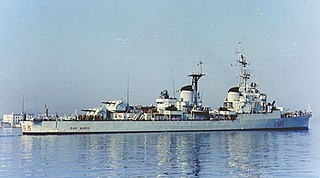
Pisa is a city and comune in Tuscany, central Italy, straddling the Arno just before it empties into the Ligurian Sea. It is the capital city of the Province of Pisa. Although Pisa is known worldwide for its leaning tower, the city contains more than twenty other historic churches, several medieval palaces, and bridges across the Arno. Much of the city's architecture was financed from its history as one of the Italian maritime republics.

Emanuele Severino was an Italian philosopher.

Bruno Munari was "one of the greatest actors of 20th century art, design and graphics." He was an Italian artist, designer, and inventor who contributed fundamentals to many fields of visual arts in modernism, futurism, and concrete art, and in non-visual arts with his research on games, didactic method, movement, tactile learning, kinesthetic learning, and creativity. On the utility of art, Munari once said, "Art shall not be separated from life: things that are good to look at, and bad to be used, should not exist."

Brionvega is an Italian electronics company that is known for manufacturing futuristic television sets and audio equipment, its contributions to post-second world war technological and social advancement in Italian industry, collaborations with well known industrial designers and architects, and its impact on the aesthetics of 1960s Italian design.

Giorgio Jan was an Italian taxonomist, zoologist, botanist, herpetologist, and writer. He is also known as Georg Jan or Georges Jan. He was the first director of the natural history museum at Milan.

SS Conte Biancamano was an Italian ocean liner launched in 1925. The name was chosen in honor of Humbert I Biancamano, founder of the Savoy dynasty. She was built in the Scottish shipyard William Beardmore & Co. in Dalmuir, near Glasgow. She was built for the Genovese shipping company Lloyd Sabaudo, operator of Conte Rosso and Conte Verde. The engine, equipped with two steam turbines double reduction unit and two propellers, allowed her to reach a speed of 20 knots, and vented in two funnels. She housed 180 passengers in first class, 220 in second class, 390 in economic class and 2,660 in third class.

The San Giorgio class are amphibious transport docks (LPD) built by Fincantieri for the Italian Navy. These ships can carry a battalion of troops, and up to 36 armored vehicles. The stern floodable dock can accommodate three landing craft. The ships are based at the Brindisi naval base on the Adriatic coast.

Museo Nazionale Scienza e Tecnologia Leonardo da Vinci in Milan, dedicated to painter and scientist Leonardo da Vinci, is the largest science and technology museum in Italy. It was opened on 5 February 1953 and inaugurated by Prime Minister Alcide De Gasperi.

The FS Class E.550 was a class of three-phase electric locomotive used in Italy, introduced in the 20th century, which remained in service until 1965.
Italian submarine Luigi Torelli was a Marconi-class submarine of the Italian navy during World War II. The vessel operated in the Atlantic from September 1940 until mid-1943, then was sent to the Far East. After Italy's surrender in 1943, the Luigi Torelli was taken over by Nazi Germany's Kriegsmarine, then, in the waning months of the war, the Japanese Imperial Navy. It was one of only two ships to serve in all three major Axis navies, the other being the Italian submarine Comandante Cappellini.

Giuseppe Mazza was an Italian painter active in a Romantic style.
Ernesto Treccani was a visual artist, writer and political activist.

Italian submarine Enrico Toti was the first of a new class of Italian submarine (Toti-class), with the S 506 Enrico Toti being laid down in 1965, launched in 1967, decommissioned in 1992 and preserved as a museum ship in Museo della Scienza e della Tecnologia "Leonardo da Vinci", in Milan. The ship, and class, are named after the Italian war hero Enrico Toti.

Franca Helg was an Italian designer and architect. She also had a career teaching at Istituto Universitario Architettura Venezia and Polytechnic of Milan. She collaborated with Franco Albini from 1945 through 1977.

The thermal power station Regina Margherita was a large power station for the production of electricity, preserved at the Museo nazionale della scienza e della tecnologia Leonardo da Vinci in Milan, Italy. The station opened in 1895 and was originally installed in the Egidio e Pio Gavazzi silk factory in Desio (Milan), where it operated until 1954. It supplied electricity for lighting and for the operation of 1,800 looms, generating alternating electric current at a voltage of 200 V.

The following outline is provided as an overview of and topical guide to Milan:

Leonardo3 is an interactive museum and exhibition center at Galleria Vittorio Emanuele II, Piazza della Scala, Milano, Italy. The museum is devoted to Italy’s notable personality Leonardo da Vinci and portrays him both as an artist and inventor.

The San Giorgio class was a class of two destroyers of the Italian Navy. They entered service in 1955, with the last one being decommissioned in 1980. Formerly Capitani Romani-class cruisers of the Regia Marina during World War II, they were rebuilt as destroyers during the Cold War. San Giorgio was the first to enter service in 1955 and was modified again from 1963 to 1965 to become a training ship until 1980. San Marco was scuttled by the Germans after the incomplete ship fell into German hands following the Italian Armistice. Following the war, the vessel was raised, rebuilt and renamed and entered service in 1956. San Marco served until 1971.


















